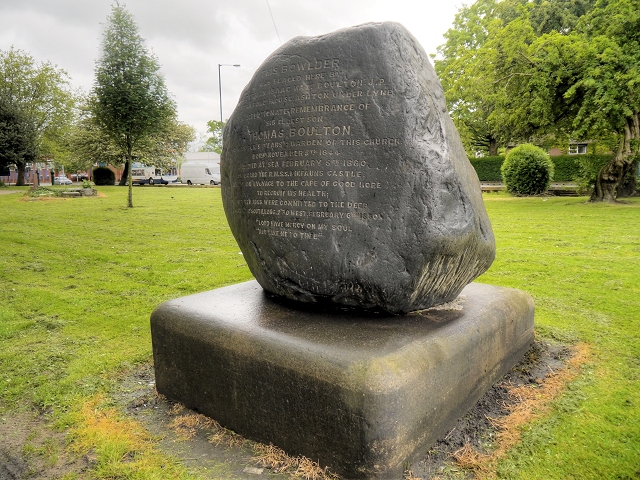POST BY ABIGAIL WINCOTT
The trail for Ashton-under-Lyne to Droylsden is partly complete. We need your help to finish it. If you can walk the route to test it, let us know what you think. If you have any extra points of interest to add, we’d love to know about them. Do you have any old pictures or artefacts relating to the canals or Ashton that we can photograph and use in our trails?
Thanks to Chris Leah of the Wooden Canal Boat Society, we have some intriguing points of interest and actually far more than we could fit into one trail. While the themes of the Holt Town trail was invisible heritage and the Ancoats trail was about underground heritage, the theme of this one is stones.
Stones, lumps of concrete, bricks – they don’t always look like much, but they have a story behind them… The more you look into the local area’s history, the more you see stone everywhere, from the limestone transported from Prince’s dock to the slates on the roofs and the cobbles beneath your feet.
Interspersed with these stone-based histories will be stories of some of the beautiful old canal boats you can still see on the Ashton Canal.
What a fascinating place Ashton is. Like many places, once you start digging you find there is so much of interest, but you have to look beneath the surface.
Droylsden – Ashton Packet Boat Company boat house
What is now a kids’ canoe centre, near the junction with Droylsden Marina, was once the boat house of the Ashton Packet Boat Company. It is made of hammer dressed stone and the roof is slate. According to its datestone it was built in 1833.
Though we tend to think of canals transporting heavy goods for industry, the Packet Boat Company ran a passenger boat for many years. Indeed before the railways, there was a regular passenger service from Ashton to Manchester. The canal was a good, fast way to get people from one town to another.
Moravian Settlement, Droylsden
Across the water from the packet boat house you can see low stone walls marking the boundary of the towpath and the land of the Moravian settlement. 
Beginning in the 15th century, the Moravian church is one of the earliest Protestant churches. The Fairfield settlement was built in the 18th century as a planned village. It has its own schools, shops, farm, fire-engine and doctor, for example. Today the settlement is still there, though there have been changes over the years.
Manchester Art Gallery has two paintings of the settlement, probably from the late 18th century. You can see how rural the setting was, but a look at satellite images today will reveal the same characteristic layout of buildings. The farmland however has been used for building.
Concrete gantry base, Ashton Packet Boat Yard, Guide Bridge
There are so many lumps and bumps of concrete and brick left behind when uses for the canal changed. Where the Ashton Packet Boat Company has their boat yard was where coal from the nearby Snipe Pit was loaded onto boats, using a big overhead gantry. The gantry is gone but the big lump of conctrete that used to support it remains, with no obvious purpose now. At one time, the Snipe pit was the deepest in the world at 2,850 feet.
Prince’s Dock
This was a canal dock, where limestone was loaded onto railway wagons. You’d hardly know now but for the fact that as you walk along the canal towpath, you find yourself walking up over a bridge, just near Oxford Mill. This bridge went over the arm of the canal going into the docks.
Portland Basin

This is home to some of the boats owned by the Wooden Canal Boat Society and to the Portland Basin Museum, full of fascinating details and artefacts about Ashton and its past.
Not only does the Wooden Canal Boat Society restore historic wooden canal boats which would otherwise rot away, they offer people experiencing loneliness, social exclusion or poor mental health the chance to volunteer and learn new skills or enjoy a little pleasurable time on the boats and by the water.
You might see their boats Hazel, Lillith, Forget-me-not or Queen.
The cobblestones


If we’re going to talk about stones – the cobbles of Ashton are something else. Not like the smooth sets modern developers put in, these are ankle twisters. The streets around show the traces of Ashton’s industrial past and the importance of the canal.
Boulton Bowlder, St Peter’s Church, Ashton
A short detour to the churchyard of St Peter’s Church. Here stands a large boulder, with inscription. It was erected by Isaac Watt Boulton to commemorate his son, Thomas, who died on a ship to South Africa and was buried at sea.
Eli Whalley’s Donkey Stone Factory, Lower Wharf Street, Ashton
On a small stone building on Lower Wharf Street in Ashton is a blue plaque, marking Eli Whalley’s donkey stone factory. Donkey stones were a kind of soft artificial stone made from reconstituted stone powder. They were used to clean and apply a temporary coloured surface to doorsteps and sometimes also window sills and pavements. The Eli Whalley factory was founded in the 1890s. It produced 2.5m donkey stones a year at its peak. It was the last place in country to manufacture donkey stones when it closed in 1979.
